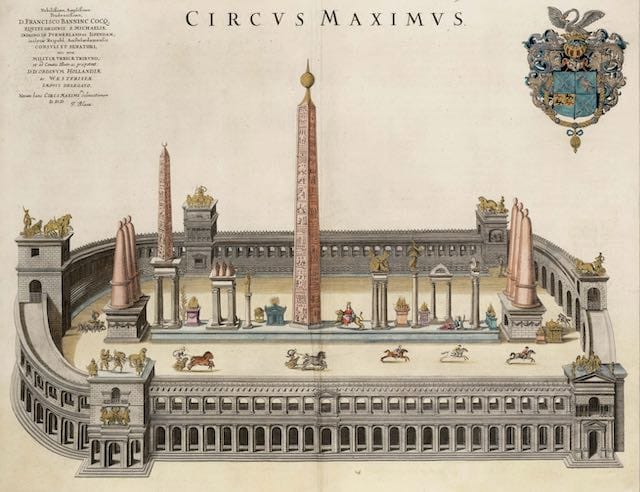Hey there, history buffs! Let’s dive into the Circus Maximus, an ancient Roman stadium where the crowds went wild and the action was epic. Get ready to learn some mind-blowing facts about this colossal arena that’s sure to make you say, “Whoa!”
Circus Maximus Fun Facts
Ever heard of the Circus Maximus? Imagine a stadium so big it makes modern-day sports arenas look tiny. That was the Circus Maximus, ancient Rome’s version of the Super Bowl, World Series, and Olympics all rolled into one!
This wasn’t your average stadium, though. Built way back in the 6th century BC, it was the place to be for chariot races, the most popular sport in ancient Rome. Picture teams of horses pulling two-wheeled chariots at breakneck speeds, drivers risking life and limb for glory – it was a spectacle that kept spectators on the edge of their seats!
Let’s dive into some mind-blowing fun facts about this ancient marvel:
- Size Matters! This place was HUGE! It stretched over 2,000 feet long and nearly 400 feet wide, meaning it could hold a whopping 150,000 people. To put that in perspective, that’s bigger than most modern football stadiums!
- Fit for an Emperor (and Vestal Virgins!) The best seats in the house belonged to the emperor himself, who enjoyed the races from a luxurious private box. Vestal Virgins, powerful women considered sacred in Roman society, also had prime seating, showing just how important this place was.
- More Than Just Chariots: While chariot races were the main attraction, the Circus Maximus wasn’t a one-trick pony (or chariot, for that matter!). Over the centuries it hosted a variety of events, from gladiatorial combat and public executions to wild animal hunts and even religious festivals. Talk about a multi-purpose venue!
- From Arena to Park: As the Roman Empire declined, so did the Circus Maximus. But instead of being completely forgotten, it was transformed into a public park. Imagine strolling through the ruins of this once-grand arena, remnants of its former glory still visible.
- Unearthing the Past: Today, archaeologists are still hard at work uncovering the secrets of the Circus Maximus. While much of it lies buried beneath modern Rome, the starting gates and parts of the seating area have been excavated, giving us a glimpse into what it must have been like to experience the thrill of the races firsthand.
The Circus Maximus may be long gone, but its legacy as a center of entertainment, spectacle, and Roman culture lives on. It serves as a reminder of the enduring power of sports and entertainment to captivate and unite people across generations.
What are some interesting facts about the Circus Maximus?
Okay, so imagine this: a stadium so big it could fit somewhere between 150,000 to 250,000 screaming fans! That, my friends, was the Circus Maximus in ancient Rome. We’re talking seriously massive – over 600 meters long and 150 meters wide! This wasn’t just some small-town arena; it was the place to be for the hottest chariot races and wild spectacles.
Now, picture twelve gates, called “carceres,” all lined up. These weren’t your average gates, though. They were specially designed to release all the chariots at the exact same time, making sure every race was a nail-biter right from the get-go. And get this – each gate represented a different faction, kind of like modern-day sports teams. You can bet the competition was fierce!
But chariot races weren’t the only game in town. The Circus Maximus was like the entertainment hub of ancient Rome. They also held gladiatorial contests there, with skilled warriors going head-to-head in brutal combat, all for the entertainment of the roaring crowd. Talk about a show!
Beyond the sports and games, the Circus Maximus was also a place of deep religious significance. The Romans held grand processions and festivals there to honor their many gods and goddesses. It was where people came together to celebrate, worship, and feel connected to something bigger than themselves.
What’s really incredible is how much thought went into the design of the Circus Maximus. The Romans were known for their architectural genius, and this place was no exception. They built a central barrier down the middle of the racetrack called the “spina.” This spina wasn’t just any old barrier; it was adorned with stunning statues, impressive fountains, and all sorts of fancy decorative elements. Not only did it look cool, but it also divided the racecourse, which added an extra layer of challenge and excitement for both the charioteers and the spectators.
The Circus Maximus wasn’t just a building; it was a symbol of Roman society and culture. It was a place where history was made, legends were born, and people from all walks of life came together to be a part of something truly extraordinary.
Why is Circus Maximus famous?
So, we’ve talked about the Circus Maximus’s impressive size – imagine a place so grand it could fit the entire population of a small city! But its fame isn’t just about size; it was the place to be in ancient Rome.
Think of it like this: if the Colosseum was where you went for a wild Friday night brawl, the Circus Maximus was the Sunday family picnic spot…with a dash of adrenaline. Sure, it mainly hosted chariot races—imagine eight horses pulling a chariot at breakneck speed, dust flying everywhere, the crowd roaring—pure excitement! And it wasn’t just a quick race; these guys zipped around the track seven times! Adding to the thrill, the track had this barrier in the middle, the spina, that wasn’t just decorative. It forced those charioteers to make some daring maneuvers, often leading to spectacular crashes (ouch!).
But it wasn’t just about the races. The Circus Maximus was like a giant fairground. You could catch gladiatorial contests, maybe even witness an exotic animal hunt. And hey, if you were lucky, you might have been there when they flooded the whole place for mock naval battles! Talk about a spectacle!
Now, imagine the emperor himself showing up! The Circus Maximus wasn’t just for fun and games; it was a powerful political tool. Emperors used it to connect with the people, throwing grand parties, giving away freebies (who doesn’t love free stuff?), and basically showing off how awesome their rule was.
And let’s not forget the architecture. This wasn’t some hastily built wooden structure. The Circus Maximus was an architectural marvel. Remember those twelve starting gates? They weren’t just for show. They made sure every chariot got a fair start, like a perfectly synchronized horse-powered drag race!
Even today, archaeologists are piecing together more clues about the Circus Maximus, which means our understanding of it might change and evolve. There’s still so much we don’t know! What we can say for sure is that the Circus Maximus wasn’t just a stadium; it was the pulsating heart of Roman entertainment, politics, and social life—a legend etched in stone and history.
How Old is the Circus Maximus?
We’ve talked about what went down at the Circus Maximus, but how old is this place anyway? Well, picture this: it was built way back in the 6th century BC. That means it’s been standing for over 2,500 years – talk about ancient history! To put it into perspective, that’s older than the Colosseum and even predates the Roman Empire itself!
This incredible age makes it one of the oldest structures still around from ancient Roman times. Think about it: for over two millennia, the Circus Maximus wasn’t just a building; it was a witness to history. It saw everything from the glory days of the Roman Republic to the fall of the Empire, and even beyond.
Of course, time takes its toll on everything, and the Circus Maximus isn’t what it used to be. What you see today are mostly ruins, whispers of its former glory. But even in its current state, you can feel the energy of the crowds, almost hear the roar of the chariots, and the cheers of the spectators echoing across the centuries.
It’s amazing to consider that while our understanding of the Circus Maximus might evolve with new discoveries, its age is a concrete fact. It’s a tangible link to a distant past, a testament to the enduring power of human ingenuity and the allure of spectacle. And who knows what secrets about this ancient wonder we might uncover in the future?
Why did they stop using the Circus Maximus?
So, we know the Circus Maximus was the place to be in ancient Rome. Imagine the roar of the crowd, the dust flying as chariots thundered around the track – pure excitement! But like all good things, its time in the spotlight eventually faded. Why, you ask? Well, it wasn’t just one thing; it was a perfect storm of factors that led to its decline.
One major reason was probably that chariot racing, the main event at the Circus, simply became less cool over time. It’s like how we might get tired of a certain type of music after a while. New forms of entertainment, like gladiatorial combat (talk about intense!), popped up and stole the show. People wanted something new and exciting, and the Circus just couldn’t keep up.
Of course, a massive structure like that needed constant care, like a prized garden. But as fewer people went to the races, there was less money to keep it in tip-top shape. Imagine a slow leak in a tire – eventually, it’s going to cause problems. Neglect and a lack of upkeep meant the Circus Maximus slowly started to crumble.
Then there were the political and economic upheavals that shook the Roman Empire. When the empire itself started to decline, resources for things like public entertainment dried up. It’s like when you tighten your budget, and outings to the amusement park are the first to go. The wealthy folks who used to sponsor the races likely found other ways to entertain themselves, leaving the Circus high and dry.
And as if things couldn’t get any worse, the Circus Maximus was situated in a flood-prone area. Regular floods wreaked havoc on the structure, and to add insult to injury, earthquakes also rattled the already weakened stadium. It’s a bit like trying to bake a cake while someone keeps bumping into your elbows – pretty tough to get a good result!
Over time, the Circus Maximus transitioned into a more practical public space. Think of it like repurposing an old factory into trendy lofts. Some areas became residential zones, while others transformed into peaceful gardens and parks. It was a far cry from its glory days as the epicenter of entertainment, becoming a place for everyday life rather than spectacular events.
It’s important to note that research on the Circus Maximus is ongoing. New discoveries might provide us with a clearer picture of its decline. However, based on current evidence, it seems like the Circus Maximus’s demise was a gradual process influenced by shifting social tastes, economic realities, natural disasters, and the changing needs of a city.
What are some old facts about the circus?
We’ve already scratched the surface of the circus’s past, but let’s dive even deeper into its fascinating history. It wasn’t all sunshine and popcorn, you know!
Imagine a time before Netflix, before video games, heck, even before radio! People craved entertainment, and the circus, in its own way, was their Super Bowl, their Hollywood, their escape from everyday life.
Now, picture this: a giant, oval-shaped arena, dusty and sun-drenched. This was the Circus Maximus in ancient Rome, and it could fit more people than your average modern football stadium! Can you believe it? They didn’t have jumbotrons back then, so you know the energy in that place was electric.
The main attraction? Chariot races! We’re talking high-speed, dangerous races with horses pulling chariots around a track. These daredevil charioteers risked their lives for glory and the roar of the crowd. Talk about dedication!
And if that wasn’t enough to get your heart racing, they also had gladiatorial combat! These weren’t your average play fights; gladiators were skilled warriors who fought with real weapons. It was a brutal spectacle, but one that drew massive crowds.
But the Circus Maximus wasn’t just about blood and guts. It also hosted religious festivals and ceremonies, showing that Romans knew how to party and pay their respects.
It’s amazing to think that a place like the Circus Maximus could hold so much history, excitement, and cultural significance. It’s a reminder that even though times change, our need for entertainment and shared experiences remains the same.
Was Circus Maximus bigger than the Colosseum?
Okay, so we’ve talked about how impressive the Colosseum is, right? But get this – the Circus Maximus was even BIGGER! Imagine a stadium so large it could fit five Colosseums inside! Yep, you read that right. The Circus Maximus, built way back in the 6th century BC, was a whopping 621 meters long and 118 meters wide. To put that in perspective, it could hold a crowd of about 250,000 people, while the Colosseum maxed out at around 50,000. Talk about a packed house!
But the Circus Maximus wasn’t just about size. This place was the heart of Roman entertainment, where the legendary chariot races took place. Picture this: teams of horses racing neck and neck, chariots kicking up dust, the roar of the crowd – it must have been absolutely electric! Beyond the races, the Circus Maximus was also used for all sorts of events, from religious festivals and gladiator contests to victory parades and even public announcements. It was like a giant, open-air stage for Roman life.
What made the Circus Maximus even cooler was how cleverly it was designed. The seating areas were built on a slope, giving everyone in the audience a pretty decent view of the action. Plus, the way the starting gates and the central barrier (called the spina) were laid out made the races super fair and added an extra layer of excitement for the spectators. And guess what? They could even host multiple chariot races at the same time! It’s amazing to think about the skill and planning that went into creating such an incredible venue.
Unfortunately, like a lot of ancient wonders, the Circus Maximus couldn’t withstand the test of time. Over the centuries, it fell into disrepair, and eventually, it was transformed into a public park. It’s kind of sad, but if you visit Rome today, you can still walk through the ruins, see parts of the starting gates and seating areas, and imagine the energy and excitement that once filled this incredible arena.
Key Takeaways:
- Let’s be clear: the Circus Maximus was way bigger than the Colosseum. Think 250,000 spectators versus 50,000 – that’s a huge difference!
- This place was THE spot for entertainment in ancient Rome, especially the famous chariot races.
- But it wasn’t just about fun and games: the Circus Maximus was also a key location for religious and political events.
- One of the coolest things is how well designed it was – everyone could see the action, and they could even hold multiple events at the same time.
- It’s a bummer that the Circus Maximus isn’t around in its full glory anymore, but exploring its ruins is still a pretty amazing experience.
What is unique about the Circus Maximus, and how many people could it hold?
So, we’ve already talked about how incredible the Circus Maximus was, but let’s dive a little deeper into what made it so special, especially its size! This place wasn’t just big—it was absolutely massive, like nothing else the Roman Empire had ever seen.
Think about it: the Colosseum is impressive, right? Well, the Circus Maximus dwarfed it! We’re talking over 2,000 feet long and almost 400 feet wide. Can you imagine trying to walk around this place?
And the crowds? Forget about it! This wasn’t just a stadium; it was THE place to be in ancient Rome. Historians believe it could hold something like 250,000 people! That’s bigger than a lot of cities today. It’s no wonder they say it hosted the largest gatherings in all of ancient Rome.
What did all those people come to watch? Well, the Circus Maximus was famous for its chariot races. Picture this: teams of horses pulling these two-wheeled chariots around a central barrier called the spina. The noise, the dust, the excitement—it must have been something else!
But the Circus Maximus wasn’t just about chariot races. It was a true multipurpose arena. They held gladiatorial combat there, too, just like in the Colosseum. And then there were the animal hunts (venatio), which were always a big spectacle. Basically, if it was exciting and dangerous, they probably did it at the Circus Maximus!
Oh, and let’s not forget the political side of things. The Circus Maximus was also a place where emperors talked to the people, announced important news, and celebrated their victories. It was a powerful symbol of Rome’s might, and being there would have been an unforgettable experience.
A lot of what we know about the Circus Maximus is based on archaeological evidence and historical texts. And while those sources give us a pretty good idea of its size and importance, there’s still a lot we don’t know for sure. For example, some experts think the actual capacity might have been even larger than we currently estimate. It’s fascinating to think about what else archaeologists might uncover in the future!
How many did the Circus Maximus hold?
Picture this: You’re in ancient Rome, and the air is buzzing with excitement. You push your way through the crowds, everyone heading to the same place – the Circus Maximus. This wasn’t just any old stadium; this was the place to be, the biggest entertainment venue in the entire Roman Empire. We’re talking a whopping 621 meters long and 118 meters wide – that’s bigger than your average city block! Historians believe that this colossal arena could squeeze in somewhere around a quarter of a million people – that’s 250,000 screaming fans! To put that in perspective, that’s more people than lived in most Roman cities at the time.
Now, you might be thinking, “Why so big?” Well, the Romans were crazy about their chariot races, and the Circus Maximus was the place to see them. Imagine the roar of the crowd as chariots thundered around the track, dust flying, horses straining, charioteers risking life and limb for glory. It was a spectacle unlike any other, and everyone, from the lowliest slave to the Emperor himself, flocked to witness it.
Even though we know the Circus Maximus was huge, nailing down the exact capacity is a bit tricky. Think about it – they didn’t have turnstiles and ticket stubs back then! Experts have poured over ancient texts, analyzed the ruins, and even used computer models to try and figure out just how many people could fit. The figure of 250,000 is a good guess, but some scholars believe it could have been even higher for special events. They might have squeezed people into every nook and cranny – standing room only!
It’s important to remember that the Circus Maximus wasn’t just about entertainment. It was a place where Romans from all walks of life came together. They cheered, they jeered, they gossiped, and they probably placed a few bets on their favorite charioteers. The Circus Maximus wasn’t just a building; it was the beating heart of Roman society.
Sadly, the Circus Maximus is now in ruins, but you can still visit the site in Rome and imagine the thunder of hooves and the roar of the crowd. It’s a powerful reminder of the grandeur of ancient Rome and the enduring power of spectacle and entertainment.
How Many Laps Did the Circus Maximus Run?
Okay, so we’ve already established that the Circus Maximus was the place to be in ancient Rome if you were into heart-stopping chariot races. But just how many times did those chariots whip around the track during a race?
Well, unlike modern races that often clock in at a specific distance, the name of the game at the Circus Maximus was laps. And it wasn’t a free-for-all either. Historical records suggest that chariot races in the Circus Maximus almost always consisted of seven laps.
Think about that for a second. Seven full circuits around that massive track! Can you imagine the endurance of those charioteers and the stamina of those horses? It must have been a true test of skill and will, not to mention a wild spectacle for the thousands upon thousands of spectators packing the stands.
While we can’t say with absolute certainty that every single race throughout the Circus Maximus’s long history stuck to this seven-lap format, the evidence we have points pretty strongly in that direction. Researchers continue to dig into ancient texts and archaeological findings, so who knows, maybe we’ll uncover some surprising variations on race day rules in the future. But for now, it’s safe to say that if you were a betting person in ancient Rome, putting your money on a seven-lap chariot race at the Circus Maximus was probably a pretty safe bet.
What was the Circus Maximus for kids?
So, we were talking about the Circus Maximus, right? Imagine a gigantic race track, but way bigger than any you’ve seen on TV! It was THE place to be in ancient Rome if you wanted to see something totally epic.
This wasn’t just a little track either. Think HUGE! It could fit more people than you could possibly imagine – something like 150,000 people! That’s like squeezing everyone from your town and the next one over into one giant stadium!
And what did all those people come to see? Well, the main attraction was chariot races! These weren’t your average horse-and-cart rides, though. We’re talking about skilled drivers, each controlling a chariot pulled by four powerful horses, zipping around the track at lightning speed. The roar of the crowd, the dust flying everywhere, the chariots thundering around the turns – it must have been incredibly exciting to watch!
But the Circus Maximus wasn’t just about chariot races. Sometimes, they held other awesome events there, like gladiator fights (imagine brave warriors battling it out!), wild animal hunts (can you believe it?!), and even musical performances!
The Circus Maximus wasn’t just about entertainment, though. It was super important to the Romans. Think of it as the heart of their city, where they celebrated holidays, held important meetings, and even showed off how powerful Rome was to the rest of the world.
Today, even though it’s mostly ruins, you can still visit the Circus Maximus when you’re in Rome. Walking around the grounds, you can almost hear the echoes of those cheering crowds and imagine those incredible chariot races from long ago! It’s a pretty cool way to touch history, don’t you think?
Want to learn more? This is just a taste of what the Circus Maximus was all about! There’s a ton more to discover, like the different teams that raced, the dangers the charioteers faced, and how the stadium changed over time. Who knows what other cool facts you’ll dig up?
Dive into the fascinating world of Deloitte with our comprehensive guide, where you’ll uncover a treasure trove of facts about facts about deloitte this renowned global consulting firm.
Uncover the intriguing history and development of the deadly facts about panzerschreck anti-tank weapon and its impact on the course of World War II.
- Unlocking Francis Alexander Shields’ Finance Empire: A Comprehensive Biography - July 12, 2025
- Unveiling Francis Alexander Shields: A Business Legacy - July 12, 2025
- Francis Alexander Shields’ Business Career: A Comprehensive Overview - July 12, 2025
















2 thoughts on “Fun Facts About the Circus Maximus”
Comments are closed.